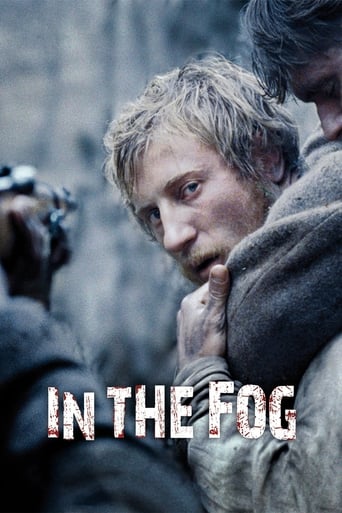Lovesusti
The Worst Film Ever
GarnettTeenage
The film was still a fun one that will make you laugh and have you leaving the theater feeling like you just stole something valuable and got away with it.
Aubrey Hackett
While it is a pity that the story wasn't told with more visual finesse, this is trivial compared to our real-world problems. It takes a good movie to put that into perspective.
Roxie
The thing I enjoyed most about the film is the fact that it doesn't shy away from being a super-sized-cliche;
Kirpianuscus
it is the film of the state after the final credits. because it is not only a war film. but a film about the thin line between fundamental choices. about the answers who defines a man more than the circumstances. and this is the motif for define "In the Fog", after a long time when I saw it, a profound special film. sure, pieces from Soviet war films are present. but it is not fair to reduce to them. because it is a film about viewer. in profound sense. an "if" who not could be reduced at a story on the screen. and this does it an useful film. and opportunity to imagine the world as a delicate balance between choices.
Daniel B
In The Fog is a film about a Soviet man, who gets released by the Germans instead of hanging him for sabotage, so everybody among the Soviets thinks he's a traitor. But he also can't cope with his guilt, so he's willing to be executed by the Soviet guerrillas.In The Fog is unlike any other war movie. It's based on a very interesting moral dilemma, and actually has a pretty good story to back that up. The cinematography and the atmosphere are also great. But it's so boring, that it almost hurt. And I don't mean by that, that it's slow, because it's not just that. There are a lot of scenes, where nothing happens. Literally minutes, when the camera is just tracking the characters walking or staring into nothing. I think half of the movie consists of walking through the woods. I feel sorry for this film, because it could have been even an all-time classic, but most of the time I was just bored to death.
Tim Cawkwell
A film from Belarus? There's always a first time, although actually this is a co-production: Germany, Netherlands, Belarus, Russia, Latvia.Set in World War Two when the invading Germans occupied Belarus, then part of the USSR, the film's title refers to the fog of war, in which participants only see the part never the whole. It also refers to the moral fog of war, whether to collaborate with the new masters or resist with the old. This is the dilemma confronting Sushenya who opts for the pacifist solution - and suffers for it.Indeed the film is an account of his 'via crucis'. It immediately brought to mind Prince Myshkin in Dostoyevsky's 'The Idiot' (Sushenya constantly being called an idiot) but more pertinent is the recollection of the donkey Balthasar in Bresson's 'Au Hasard Balthasar'. Balthasar is the intelligent but mute witness to the sufferings of humanity around him, and a victim too. Indeed Sushenya's insistence on trying to carry the wounded Burov on his back to safety makes of him, like Balthasar, a beast of burden.I would hesitate before concluding that the director, Sergei Loznitsa, is steeped in 'Au Hasard Balthasar', let alone all of Bresson's work (although the forest scenes certainly have their echo in Bresson's 'Mouchette', again perhaps more by coincidence than design) but there are strong Bressonian virtues in the film. 1) The flashback structure gives us effects before causes, a key narrative strategy of Bresson's; 2) the protagonists are closer to Bressonian 'models' than actors, since their faces are quite new to Western audiences and Loznitsa directs them to speak in a subdued manner; 3) no music to tell us what to feel! God (who invented music) be praised; 4) Loznitsa withholds judgement, presenting the story 'without ornaments' (as Bresson said of his 'A Man Escaped').In the subtlest of ways, Loznitsa sketches Sushenya as a Christ figure. With his beard, his tousled hair and his long face, he seems to step out of an icon-painting. And at the end, sitting between Burov and Voitik, he is Christ flanked by the two thieves.
magus-9
Loznitsa's MY JOY was one of the very best films of 2010, and so I was very much looking forward to seeing this. Whilst it is not as ground- breaking and arresting as the earlier film, it is still a fine entry in the long-standing tradition of the (ex-)Soviet war film... The setting is Belarus under German control, calling Klimov's COME AND SEE to mind, but this is a much more low-key, sober, elegant film concerning the muddy morality and conflicted ethical choices of war-time. Its quasi Jesus-like central figure recalls Shepitko's THE ASCENT, but whilst Shepitko's Jesus is sacrificed, Loznitsa's finds that suicide can be the only solution to the ethical dilemma of how to be Good in an internecine war. In a situation where to do nothing is collusion, where to be spared death is seen as collaboration with the enemy, where betrayal and suspicion are stronger than loyalty and solidarity, there is no room for virtue. This bleak world-view echoes the darkness of MY JOY, but in this film, Oleg Mutu's typically brilliant cinematography is bright and sharp, luminous. Beautiful forests surround the sinful and sinning characters; the irony of the beautiful world in which human ugliness takes centre stage.

